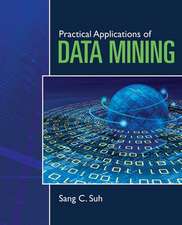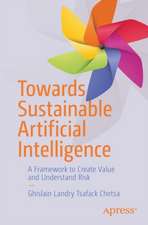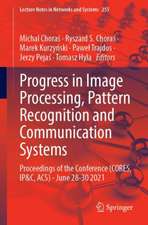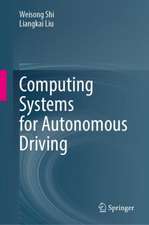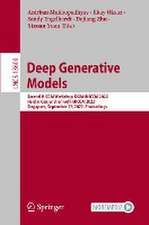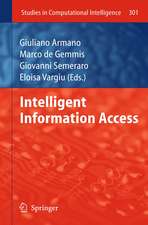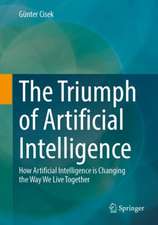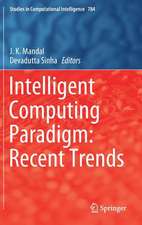Information Systems Design and Intelligent Applications: Proceedings of Second International Conference INDIA 2015, Volume 2: Advances in Intelligent Systems and Computing, cartea 340
Editat de J. K. Mandal, Suresh Chandra Satapathy, Manas Kumar Sanyal, Partha Pratim Sarkar, Anirban Mukhopadhyayen Limba Engleză Paperback – 4 feb 2015
| Toate formatele și edițiile | Preț | Express |
|---|---|---|
| Paperback (2) | 1301.97 lei 6-8 săpt. | |
| Springer India – 4 feb 2015 | 1301.97 lei 6-8 săpt. | |
| Springer India – 3 feb 2015 | 2213.23 lei 6-8 săpt. |
Din seria Advances in Intelligent Systems and Computing
- 20%
 Preț: 1120.90 lei
Preț: 1120.90 lei - 20%
 Preț: 1090.59 lei
Preț: 1090.59 lei - 20%
 Preț: 1324.07 lei
Preț: 1324.07 lei - 20%
 Preț: 1989.79 lei
Preț: 1989.79 lei - 20%
 Preț: 1946.92 lei
Preț: 1946.92 lei - 18%
 Preț: 1273.28 lei
Preț: 1273.28 lei - 20%
 Preț: 2264.51 lei
Preț: 2264.51 lei - 20%
 Preț: 1337.27 lei
Preț: 1337.27 lei - 20%
 Preț: 1297.67 lei
Preț: 1297.67 lei - 20%
 Preț: 1315.82 lei
Preț: 1315.82 lei - 20%
 Preț: 1310.88 lei
Preț: 1310.88 lei - 20%
 Preț: 1302.62 lei
Preț: 1302.62 lei - 20%
 Preț: 882.20 lei
Preț: 882.20 lei - 20%
 Preț: 1305.93 lei
Preț: 1305.93 lei - 20%
 Preț: 1629.32 lei
Preț: 1629.32 lei - 20%
 Preț: 1345.49 lei
Preț: 1345.49 lei - 18%
 Preț: 1227.52 lei
Preț: 1227.52 lei - 18%
 Preț: 1290.64 lei
Preț: 1290.64 lei - 20%
 Preț: 1041.10 lei
Preț: 1041.10 lei - 20%
 Preț: 1034.52 lei
Preț: 1034.52 lei - 20%
 Preț: 1298.50 lei
Preț: 1298.50 lei - 20%
 Preț: 1330.67 lei
Preț: 1330.67 lei - 20%
 Preț: 1483.28 lei
Preț: 1483.28 lei - 20%
 Preț: 1971.64 lei
Preț: 1971.64 lei - 20%
 Preț: 1006.48 lei
Preț: 1006.48 lei - 20%
 Preț: 1471.75 lei
Preț: 1471.75 lei - 20%
 Preț: 1471.56 lei
Preț: 1471.56 lei - 20%
 Preț: 1454.40 lei
Preț: 1454.40 lei - 20%
 Preț: 1494.84 lei
Preț: 1494.84 lei - 20%
 Preț: 1269.64 lei
Preț: 1269.64 lei - 20%
 Preț: 1481.64 lei
Preț: 1481.64 lei - 20%
 Preț: 1192.08 lei
Preț: 1192.08 lei - 20%
 Preț: 1298.50 lei
Preț: 1298.50 lei - 20%
 Preț: 1489.07 lei
Preț: 1489.07 lei - 20%
 Preț: 825.78 lei
Preț: 825.78 lei - 20%
 Preț: 1649.93 lei
Preț: 1649.93 lei - 20%
 Preț: 1463.49 lei
Preț: 1463.49 lei - 20%
 Preț: 1438.77 lei
Preț: 1438.77 lei - 20%
 Preț: 1474.22 lei
Preț: 1474.22 lei - 20%
 Preț: 1298.50 lei
Preț: 1298.50 lei - 20%
 Preț: 1327.35 lei
Preț: 1327.35 lei - 20%
 Preț: 1973.31 lei
Preț: 1973.31 lei - 18%
 Preț: 947.04 lei
Preț: 947.04 lei - 18%
 Preț: 1441.39 lei
Preț: 1441.39 lei - 20%
 Preț: 638.55 lei
Preț: 638.55 lei - 20%
 Preț: 1320.76 lei
Preț: 1320.76 lei - 20%
 Preț: 1948.56 lei
Preț: 1948.56 lei
Preț: 1301.97 lei
Preț vechi: 1627.46 lei
-20% Nou
Puncte Express: 1953
Preț estimativ în valută:
249.21€ • 270.79$ • 209.47£
249.21€ • 270.79$ • 209.47£
Carte tipărită la comandă
Livrare economică 21 aprilie-05 mai
Preluare comenzi: 021 569.72.76
Specificații
ISBN-13: 9788132222460
ISBN-10: 8132222466
Pagini: 908
Ilustrații: XXX, 877 p. 337 illus.
Dimensiuni: 155 x 235 x 48 mm
Greutate: 1.25 kg
Ediția:2015
Editura: Springer India
Colecția Springer
Seria Advances in Intelligent Systems and Computing
Locul publicării:New Delhi, India
ISBN-10: 8132222466
Pagini: 908
Ilustrații: XXX, 877 p. 337 illus.
Dimensiuni: 155 x 235 x 48 mm
Greutate: 1.25 kg
Ediția:2015
Editura: Springer India
Colecția Springer
Seria Advances in Intelligent Systems and Computing
Locul publicării:New Delhi, India
Public țintă
ResearchCuprins
Paper 1: An In-silico Structural Analysis of the Interactions of SoxY and SoxZ from Moderately Thermophilic Betaproteobac-terium, Hydrogenophilus Thermoluteolus in the Global Sulfur Oxidation Cycle.- Paper 2: The Effect of T192M Mutation in Stability of Alpha Dystroglycan: Study with Molecular Dynamics Simulation.- Paper 3: Intermolecular Interaction Study of Dissimilatory Sulfite Reductase (DsrAB) from Sulfur Oxidizing Proteobacteria Allchromatium Vinosum.- Paper 4: Structural Bioinformatics Approach to Understand the Molecular Mechanism of the Interactions of Small Heat Shock Proteins IbpA and IbpB with Lon Protease.- Paper 5: Computer Based Self-pacing Instructional Design Approach in Learning with Respect to Gender as a Variable.- Paper 6: Use of Machine Learning Features to Detect Protein-protein Interaction Sites at the Molecular Level.- Paper 7: Mutual Interaction Study between DnaK-GroEL-FtSH with Heat Shock Regulator 32 to Explain Prokaryotic Heat Shock Regulation.- Paper 8: Molecular Structure and Packing Analysis of two Nematogenic Fluoro-phenyl Compounds in the Crystalline Phase.- Paper 9: Fractal Image Compression with Adaptive Quadtree Partitioning and Lossless Encoding on the Parameters of Affine Transformations.- Paper 10: EMD Based Features for Discrimination of Focal and Non-focal EEG Signals.- Paper 11: HHT Based Features for Discrimination of EMG Signals.- Paper 12: Understanding the Interaction of Human Formin Binding Protein 4 with Formin FMN1.- Paper 13: In-silico Structural Analysis of SoxF Protein through Molecular Modelling and Protein-protein Docking from Hydrogenophilus Thermoluteolus: An Approach to Understand the Molecular Mechanism of Thiosulfate Oxidation.- Paper 14: Structural Analyses of the Mode of Binding between AANAT Protein with 14-3-3 Protein Involved in Human Melatonin Synthesis.- Paper 15: Development of E-Learning System in Grid Environment.- Paper 16: A Weighted Concept Map Approach to Generate Learning Guidance in Science Courses.- Paper 17: Fingerprint Recognition by Divide and Conquer Method.- Paper 18: Nonlocal Speckle Denoising Model Based on Non-linear Partial Differential Equations.- Paper 19: Optimal Multilevel Image Threshold Selection Using a Novel Objective Function.- Paper 20: Molecular Docking Analysis of AHL Molecule on Plant Protein ARR10.- Paper 21: A Remote Login Password Authentication Scheme Using Row Vector with Biometric.- Paper 22: A Symmetric Key Cryptosystem Using DNA Sequence with OTP key.- Paper 23: Text Localization in Camera Captured Images Using Adaptive Stroke Filter.- Paper 24: Dynamic Modeling of Three Link Finger Manipulator.- Paper 25: Dynamic Reconfigurable Architectures – A Boon for Desires of Real Time Systems.- Paper 26: A Real Time Gesture Recognition with Wrist Mounted Accelerometer.- Paper 27: Effectiveness of Proximity-Based Outlier Analysis in Detecting Profile-Injection attacks in E Commerce Recommender Systems.- Paper 28: Novel Approach of Multiplier Design Using Ancient Vedic Mathematics.- Paper 29: Supply Chain Model for Deteriorating Items with Imperfect Production Process Under Budget Constraint.- Paper 30: Line-level Script Identification for Six Handwritten Scripts Using Texture Based Features.- Paper 31: Single Sensor Color filter Array Interpolation Algorithms.- Paper 32: Region Based Image Retrieval Using Integrated Color, Texture and Shape Features.- Paper 33: Automatic Generation of Web Service Composition Templates Using WSDL Descriptions.- Paper 34: Poisson Noise Removal from Mammogram Using Poisson Unbiased Risk Estimation Technique.- Paper 35: A Proposed Systematic user-interface Design Framework for Synchronous and Asynchronous E-learning Systems.- Paper 36:Differential Power Analysis: Attacks and Resisting Techniques.- Paper 37: Health-system Evaluation: A Multi-attribute Decision Making Approach.- Paper 38: Analysis and Evaluation of Image Quality Metrics.- Paper 39: Comparative Analysis of Color Image Encryption Using 2D Chaotic Maps.- Paper 40: Automatic Model Extraction from C Code - Abstracter and Architecture.- Paper 41: Remote Sensing Image Registration Based on Particle Swarm Optimization and Mutual Information.- Paper 42: Enzyme Function Classification Based on Sequence Alignment.- Paper 43: A Novel Biometric Fingerprint Template Based Method for Stream Cipher Design .- Paper 44: A Non-Linear Diffusion Based Partial Differential Equation Model for Noise Reduction in Images.- Paper 45: A Pixel Based Segmentation Scheme for Fingerprint Images.- Paper 46: Distance Similarity as a CBR Technique for Early Detection of Breast Cancer: An Egyptian Case Study.- Paper 47: Modified PCT on Variable Cipher Block Chaining Mode.- Paper 48: A Fast and Efficient Mesh Smoothing Algorithm for 3D Graphical Models Using Cubic B-Splines.- Paper 49: Text Extraction from Scene Images through Local Binary Pattern and Business Features Based Color Image Segmentation.- Paper 50: Age Group Classification of Facial Images Using Rank Based Edge Texture Unit (RETU).- Paper 51: Writer Identification from Handwritten Devanagari Script.- Paper 52: Quality Estimation of MT-Engine Output Using Language Models for Post-editing and their Comparative Study.- Paper 53: Genetic Algorithm with Improved Mutation Operator for Multiple Sequence Alignment.- Paper 54: Analysis of Induced Color for Automatic Detection of ROI in Multipose AVSR System.- Paper 55: Conditional Spatial Fuzzy C-means Clustering Algorithm with Application in MRI Image Segmentation.- Paper 56: Advancement in Guard Zone Computationthrough Detection and Exclusion of the Overlapped Regions.- Paper 57: Design of a Mixer for Performing Efficient Mixing to Reduce Overall Assay Response Time.- Paper 58: Remotely Functional-Analysis of Mental Stress Based on GSR Sensor Physiological Data in Wireless Environment.- Paper 59: Dynamic Software Metrics for Object Oriented Software: A Review.- Paper 60: Big Data Analytics and its Prospects in Computational Proteomics.- Paper 61: The Future ICT Education in India – A Pilot Study on the Vision of Ubiquitous Learning in Higher Education.- Paper 62: Study of Various Feature Extraction and Selection Techniques for Drought Prediction in Precision Agriculture.- Paper 63: Automatic Segmentation of Spoken Word Signals into Letters Based on Amplitude Variation for Speech to Text Transcription.- Paper 64: Logically Organised Sensor Based Prototype Model for Automatic Control of Process Temperature.- Paper 65: Investigations into the Goodness of Posts in Q&A Forums – Popularity vs. Quality.- Paper 66: Color Video Compression Based on Fractal Coding Using Quadtree Weighted Finite Automata.- Paper 67: BIG Data Analysis for Indian E-Governance Projects - A Proposed Framework to Improve Real Time Reporting.- Paper 68: Role of Team Leaders in Employee Faith in the Performance Appraisal Practices: An Exploratory Study on the Software Professionals in Some selected IT Companies in West Bengal (India).- Paper 69: Automatic Bus Fare Collection System in India.- Paper 70: Secure E-Learning Framework (SeLF).- Paper 71: Embedding an Extra Layer of Data Compression Scheme for Efficient Management of Big-Data.- Paper 72: Automatic Gesture Recognition for Health Care Using Relief and Fuzzy kNN.- Paper 73: Volume Cutting of Medical Data Using Deformable Surfaces Modeled with Level Sets.- Paper 74: Improved DB-SCAN for Detecting Zonal Followers forSmall Regions on Twitter.- Paper 75: Cooperative Revocation of Misbehaving Vehicles from VANET.- Paper 76: Identification and Recognition of Defects in Civil Structures Using Non-Destructive Technique.- Paper 77: Efficient Knowledge Transformation for Incremental Learning and Detection of New Concept Class in Students Classification System.- Paper 78: A Software Project Risk Analysis Tool Using Software Development Goal Modeling Approach.- Paper 79: Modeling Agility in Internet of Things (IoT) Architecture.- Paper 80: Authentication in Higher Region of Convergence of Z Transform Domain (AHRocZ).- Paper 81: Bilateral Filtering in Wavelet Domain for Synthesis of Flash and No-Flash Image Pairs.- Paper 82: Simulation Tool for Assignment Model: ASSOLVE.- Paper 83: Pharmaco-Informatics: An Interaction Study of Herbal Compounds with Receptors Implicated in ADHD.- Paper 84: Restoration Algorithm for Gaussian Corrupted MRI Using Non-Local Averaging.- Paper 85: Multi-objective Optimization Based Software Testing Using Kansei Quality Approach.- Paper 86: Prediction of Occurrence of Heart Disease and its Dependability on RCT Using Data Mining Techniques.- Paper 87: An Artificial Neural Networks Model by Using Wavelet Analysis for Speaker Recognition.
Notă biografică
Being M.Sc. in Physics from Jadavpur University in 1986, M.Tech. in Computer Science from University of Calcutta, Prof. J.K. Mandal was awarded PhD. in Computer Science & Engineering by Jadavpur University in 2000. Presently, he is working as Professor of Computer Science & Engineering and former Dean, Faculty of Engineering, Technology and Management, Kalyani University, Kalyani, Nadia, West Bengal for two consecutive terms. He started his career as lecturer at NERIST, Arunachal Pradesh in Sept., 1988. He has teaching and research experience of 25 years. His areas of research include coding theory, data and network security, remote sensing and GIS based applications, data compression, error correction, visual cryptography, steganography, security in MANET, wireless networks and unify computing. He has produced 9 PhD. degrees, one submitted (2013) and 8 are ongoing. He has supervised 3 M. Phil and 26 M. Tech. He is life member of Computer Society of India since 1992, CRSI since 2009, ACM since 2012 IEEE since 2013 and Fellow member of IETE since 2012, Executive member of CSI Kolkata Chapter. He has chaired 17 sessions in various International Conferences and delivered 20 expert/invited lectures. He is reviewer of various International Journals and Conferences. He has over 284 articles and 5 books published to his credit.
Dr. Suresh Chandra Satapathy is currently working as Professor and Head, Dept. of CSE at Anil Neerukonda Institute of Technology and Sciences (ANITS), Andhra Pradesh, India. He obtained his Ph. D. in Computer Science and Engineering from JNTU Hyderabad and M. Tech in CSE from NIT, Rourkela, Odisha, India. He has 26 years of teaching experience. His research interests are data mining, machine intelligence and swarm intelligence. He has acted as program chair of many international conferences and edited 6 volumes of proceedings from Springer LNCS and AISC series. He is currently guiding 8 scholars for PhDs. Dr. Satapathy is also a Sr. Member IEEE.
Dr. Manas Kumar Sanyal obtained his M.Tech. in Computer Science from Calcutta University in 1989. He worked in the Industries for about four years and joined as Lecture at BCKV in the year 1994 and obtained his PhD. in the year 2003. Presently he is working as Dean, Faculty of Engineering, Technology and Management in University of Kalyani, Kalyani, West Bengal. His current research interests include Big Data, e-governance, e-procurement data warehousing and data mining. In addition to presenting his work at numerous international conferences, Dr. Sanyal has also organized and chaired several international and national conferences. He has contributed over 100 research papers in various international journals and proceedings of international conferences.
Dr. Partha Pratim Sarkar obtained his PhD. in Engineering from Jadavpur University in the year 2002. He obtained his M.E. from Jadavpur University in 1994 and B.E. in Electronics and Telecommunication Engineering from Bengal Engineering College in 1991. He is presently working as Senior Scientific Officer (professor rank) at D.E.T.S, University of Kalyani, India. His areas of research include microstrip antenna, microstrip filter, frequency selective surfaces and artificial neural network. He has contributed over 210 research articles in various journals and conferences of international repute. He is a life fellow of IETE, and fellow of IE (India).
Dr. Anirban Mukhopadhyay is an Associate Professor and former Head of the Department of Computer Science and Engineering, University of Kalyani, West Bengal, India. He did his B.E. from National Institute of Technology, Durgapur, India, in 2002 and M.E. from Jadavpur University, Kolkata, India, in 2004, respectively. He obtained his Ph.D. in Computer Science and Engineering from Jadavpur University in 2009. Dr. Mukhopadhyay is the recipient of the University Gold Medal and Amitava Dey Memorial Gold Medal from Jadavpur Universityin 2004. He also received Erasmus Mundus fellowship in 2009 to carry out post-doctoral research at University of Heidelberg and German Cancer Research Center (DKFZ), Heidelberg, Germany during 2009-10. Dr. Mukhopadhyay also visited I3S laboratory, University of Nice Sophia-Antipolis, Nice, France in 2011 as a Visiting Professor, and University of Goettingen, Germany, as a Visiting Scientist with DAAD scholarship in 2013. He has received Institution of Engineers, India (IEI) Young Engineers Award (2013-14) and Indian National Academy of Engineering (INAE) Young Engineer Award (2014). He has co-authored one book and more than 100 research papers in various International Journals and Conferences. He is a senior member of IEEE, USA, and member of Association for Computing Machinery (ACM), USA. His research interests include soft and evolutionary computing, data mining, multiobjective optimization, pattern recognition, bioinformatics, and optical networks.
Dr. Suresh Chandra Satapathy is currently working as Professor and Head, Dept. of CSE at Anil Neerukonda Institute of Technology and Sciences (ANITS), Andhra Pradesh, India. He obtained his Ph. D. in Computer Science and Engineering from JNTU Hyderabad and M. Tech in CSE from NIT, Rourkela, Odisha, India. He has 26 years of teaching experience. His research interests are data mining, machine intelligence and swarm intelligence. He has acted as program chair of many international conferences and edited 6 volumes of proceedings from Springer LNCS and AISC series. He is currently guiding 8 scholars for PhDs. Dr. Satapathy is also a Sr. Member IEEE.
Dr. Manas Kumar Sanyal obtained his M.Tech. in Computer Science from Calcutta University in 1989. He worked in the Industries for about four years and joined as Lecture at BCKV in the year 1994 and obtained his PhD. in the year 2003. Presently he is working as Dean, Faculty of Engineering, Technology and Management in University of Kalyani, Kalyani, West Bengal. His current research interests include Big Data, e-governance, e-procurement data warehousing and data mining. In addition to presenting his work at numerous international conferences, Dr. Sanyal has also organized and chaired several international and national conferences. He has contributed over 100 research papers in various international journals and proceedings of international conferences.
Dr. Partha Pratim Sarkar obtained his PhD. in Engineering from Jadavpur University in the year 2002. He obtained his M.E. from Jadavpur University in 1994 and B.E. in Electronics and Telecommunication Engineering from Bengal Engineering College in 1991. He is presently working as Senior Scientific Officer (professor rank) at D.E.T.S, University of Kalyani, India. His areas of research include microstrip antenna, microstrip filter, frequency selective surfaces and artificial neural network. He has contributed over 210 research articles in various journals and conferences of international repute. He is a life fellow of IETE, and fellow of IE (India).
Dr. Anirban Mukhopadhyay is an Associate Professor and former Head of the Department of Computer Science and Engineering, University of Kalyani, West Bengal, India. He did his B.E. from National Institute of Technology, Durgapur, India, in 2002 and M.E. from Jadavpur University, Kolkata, India, in 2004, respectively. He obtained his Ph.D. in Computer Science and Engineering from Jadavpur University in 2009. Dr. Mukhopadhyay is the recipient of the University Gold Medal and Amitava Dey Memorial Gold Medal from Jadavpur Universityin 2004. He also received Erasmus Mundus fellowship in 2009 to carry out post-doctoral research at University of Heidelberg and German Cancer Research Center (DKFZ), Heidelberg, Germany during 2009-10. Dr. Mukhopadhyay also visited I3S laboratory, University of Nice Sophia-Antipolis, Nice, France in 2011 as a Visiting Professor, and University of Goettingen, Germany, as a Visiting Scientist with DAAD scholarship in 2013. He has received Institution of Engineers, India (IEI) Young Engineers Award (2013-14) and Indian National Academy of Engineering (INAE) Young Engineer Award (2014). He has co-authored one book and more than 100 research papers in various International Journals and Conferences. He is a senior member of IEEE, USA, and member of Association for Computing Machinery (ACM), USA. His research interests include soft and evolutionary computing, data mining, multiobjective optimization, pattern recognition, bioinformatics, and optical networks.
Textul de pe ultima copertă
The second international conference on INformation Systems Design and Intelligent Applications (INDIA – 2015) held in Kalyani, India during January 8-9, 2015. The book covers all aspects of information system design, computer science and technology, general sciences, and educational research. Upon a double blind review process, a number of high quality papers are selected and collected in the book, which is composed of two different volumes, and covers a variety of topics, including natural language processing, artificial intelligence, security and privacy, communications, wireless and sensor networks, microelectronics, circuit and systems, machine learning, soft computing, mobile computing and applications, cloud computing, software engineering, graphics and image processing, rural engineering, e-commerce, e-governance, business computing, molecular computing, nano computing, chemical computing, intelligent computing for GIS and remote sensing, bio-informatics and bio-computing. These fields are not only limited to computer researchers but also include mathematics, chemistry, biology, bio-chemistry, engineering, statistics, and all others in which computer techniques may assist.
Caracteristici
Covers novel and original research in computer science and information technology Focuses on topics like natural language processing, artificial intelligence, cyber forensics, software engineering and virtualization Discusses intelligent tools which can be applied for solving various challenging IT related problems Includes supplementary material: sn.pub/extras

